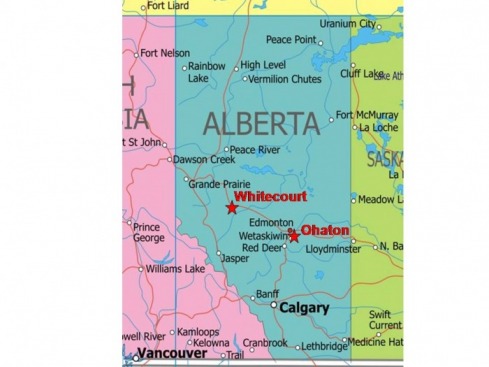Amy Gainer
Introduction
Background

In 2007, the Canadian Forest Service (CFS), Canadian Biomass Innovation Network (CBIN), Alberta Environment, Geoflow Inc. and others created an applied research and demonstration project called the “Willow Biomass Project” (the Project). The purpose of the Project is to determine the feasibility of incorporating treated municipal water(from here on in just waste water) into the production of short rotation woody crops (SRWC), in Alberta. SRWC is “a silvicultural system based upon short clear-felling cycles, generally between one and 15 years, employing intensive cultural techniques such as fertilization, irrigation and weed control, and utilizing genetically superior planting material” (Dickman, 2004). The project involves irrigating willow and poplar species with wastewater and analysing which species under which irrigation treatment has the greatest biomass.
Water resources are becoming increasingly scarce and are given priority allocation to urban uses (Beltrain 1999). For this reason, it has become more reasonable to use alternate irrigation water sources such as municipal or industrial wastewater. If successful, the Project would become a renewable form of energy for local communities, an alternate waste water treatment process and a viable method of re using water.
This type of approach to bioenergy production has been extensively studied in Europe by countries such as Sweden who have found various benefits. Both willow and poplar are non edible crops so there is no threat of constituents in waste water reaching humans via edible consumption. This method of waste water treatment is relatively more cost effective than conventional treatment because waste water is a comparably less expensive form of both irrigation water and fertilizer (Dimitrou and Aronsson 2005). Rather than discharging water into surface water bodies like rivers or lagoons where eutrophication typically occurs, the waste water is diverted to further treatment on land (Bjorssen and Berndes 2006). Reusing waste water decreases pressure on fresh water resources.
A common problem with irrigation of water with various constituents found in agricultural settings is salinization of soil. Soil salinization is a natural proccess and involvles accumulation ofsalts in the root zone. Salts include ions such as chloride, sulphate, magnesium, calcium and carbonate. Some of these salts are plant essential nutrients but salts such as sodium can have detrimental affects on soil quality. Due to its large hydrated radius, sodium causes particle dispersion, reducing the soils porosity and infiltration. These processes are important for plants and microorganisms in the soil. Excess salts, in general, in the root zone decrease the amount of water a crop can take up by creating osmotic forces.
In general, salinity decreases the overall soil quality which may limit the productivity and longevity of the project. This research is important for the future of a potential bioenergy source. By adopting bioenenery, there will be less fear of running out of oil and more certainty in our future.
Water resources are becoming increasingly scarce and are given priority allocation to urban uses (Beltrain 1999). For this reason, it has become more reasonable to use alternate irrigation water sources such as municipal or industrial wastewater. If successful, the Project would become a renewable form of energy for local communities, an alternate waste water treatment process and a viable method of re using water.
This type of approach to bioenergy production has been extensively studied in Europe by countries such as Sweden who have found various benefits. Both willow and poplar are non edible crops so there is no threat of constituents in waste water reaching humans via edible consumption. This method of waste water treatment is relatively more cost effective than conventional treatment because waste water is a comparably less expensive form of both irrigation water and fertilizer (Dimitrou and Aronsson 2005). Rather than discharging water into surface water bodies like rivers or lagoons where eutrophication typically occurs, the waste water is diverted to further treatment on land (Bjorssen and Berndes 2006). Reusing waste water decreases pressure on fresh water resources.
A common problem with irrigation of water with various constituents found in agricultural settings is salinization of soil. Soil salinization is a natural proccess and involvles accumulation ofsalts in the root zone. Salts include ions such as chloride, sulphate, magnesium, calcium and carbonate. Some of these salts are plant essential nutrients but salts such as sodium can have detrimental affects on soil quality. Due to its large hydrated radius, sodium causes particle dispersion, reducing the soils porosity and infiltration. These processes are important for plants and microorganisms in the soil. Excess salts, in general, in the root zone decrease the amount of water a crop can take up by creating osmotic forces.
In general, salinity decreases the overall soil quality which may limit the productivity and longevity of the project. This research is important for the future of a potential bioenergy source. By adopting bioenenery, there will be less fear of running out of oil and more certainty in our future.
Research Objectives
Does irrigation with wastewater impact soil quality by causing salinzation?
Expected Results
It is expected that soil receiving wastewater will have higher salinity levels. It is expected that the shallower depths will have a higher salinity. It is expected that the naturally saline soil will have reduces salinity after irrigation with both tap water and wastewater.
Waste water irrigation will increase soil salinity but there are options available to improve the soil quality. The project will be limited by this setback.
Waste water irrigation will increase soil salinity but there are options available to improve the soil quality. The project will be limited by this setback.
